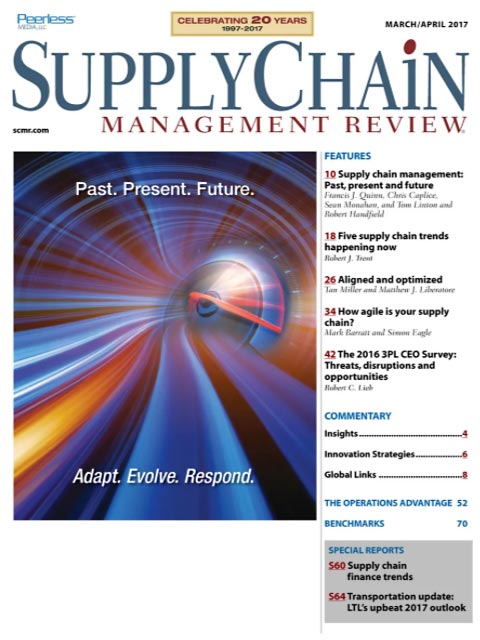Sorry, but your login has failed. Please recheck your login information and resubmit. If your subscription has expired, renew here.
March-April 2017
Supply Chain Management Review, which is celebrating its 20th anniversary with this issue.Twenty years after the premier issue, our goal remains the same: To present thought leadership around best practices in supply chain fundamentals, publish case study examples of what leading companies are doing in their supply chains and keep our finger on the pulse of emerging trends and technologies that will shape the future. While Frank’s essay looks to the past and brings us to the present, we also have essays from four experienced supply chain professionals looking to the future of supply chain management. Browse this issue archive.Need Help? Contact customer service 847-559-7581 More options
As we roll into 2017, it’s clear that the $36 billion less-than-truckload (LTL) sector is enjoying a financial renaissance as carriers continue their new-found pricing discipline and resist the urge to expand capacity beyond fulfilling immediate shipper needs.
“Overall, the first quarter of 2017 is looking upbeat from an economic standpoint,” says Wayne Spain, president and COO of Averitt Express, the nation’s 12th-largest LTL carrier. “We’re seeing many positive indicators, including comfortable growth in the months leading up to 2017 and the reaction of markets to the new presidential administration.”
Others close to the market can do nothing but agree with Spain’s positive sentiments. According to Satish Jindel, principal of SJ Consulting, an analyst firm that tracks the LTL sector, the new President’s “America First” promise could pay dividends in the LTL sector—eventually. “It won’t show up immediately, but the new administration’s focus on keeping more business in the United States should translate into more freight,” he projects. “There could be a time lag, but that should be a positive.”

This complete article is available to subscribers only.
Log in now for full access or start your PLUS+ subscription for instant access.
SC
MR
Sorry, but your login has failed. Please recheck your login information and resubmit. If your subscription has expired, renew here.
March-April 2017
Supply Chain Management Review, which is celebrating its 20th anniversary with this issue.Twenty years after the premier issue, our goal remains the same: To present thought leadership around best practices in supply… Browse this issue archive. Access your online digital edition. Download a PDF file of the March-April 2017 issue.
As we roll into 2017, it's clear that the $36 billion less-than-truckload (LTL) sector is enjoying a financial renaissance as carriers continue their new-found pricing discipline and resist the urge to expand capacity beyond fulfilling immediate shipper needs.
“Overall, the first quarter of 2017 is looking upbeat from an economic standpoint,” says Wayne Spain, president and COO of Averitt Express, the nation's 12th-largest LTL carrier. “We're seeing many positive indicators, including comfortable growth in the months leading up to 2017 and the reaction of markets to the new presidential administration.”
Others close to the market can do nothing but agree with Spain's positive sentiments. According to Satish Jindel, principal of SJ Consulting, an analyst firm that tracks the LTL sector, the new President's “America First” promise could pay dividends in the LTL sector—eventually. “It won't show up immediately, but the new administration's focus on keeping more business in the United States should translate into more freight,” he projects. “There could be a time lag, but that should be a positive.”
SC
MR


Latest Supply Chain News
- How S&OP provides the answer to in-demand products
- AI, virtual reality is bringing experiential learning into the modern age
- Humanoid robots’ place in an intralogistics smart robot strategy
- Tips for CIOs to overcome technology talent acquisition troubles
- There is still work to do to achieve supply chain stability
- More News
Latest Podcast

 Explore
Explore
Latest Supply Chain News
- How S&OP provides the answer to in-demand products
- AI, virtual reality is bringing experiential learning into the modern age
- Humanoid robots’ place in an intralogistics smart robot strategy
- Tips for CIOs to overcome technology talent acquisition troubles
- There is still work to do to achieve supply chain stability
- Blooming success: The vital role of S&OE in nurturing global supply chains
- More latest news
Latest Resources

Subscribe

Supply Chain Management Review delivers the best industry content.

Editors’ Picks





